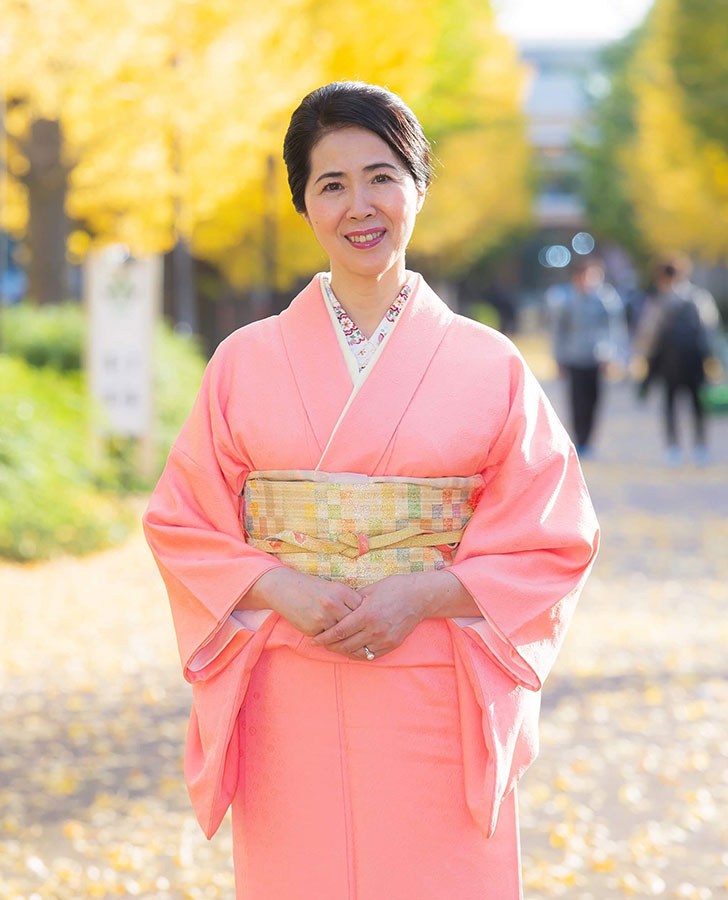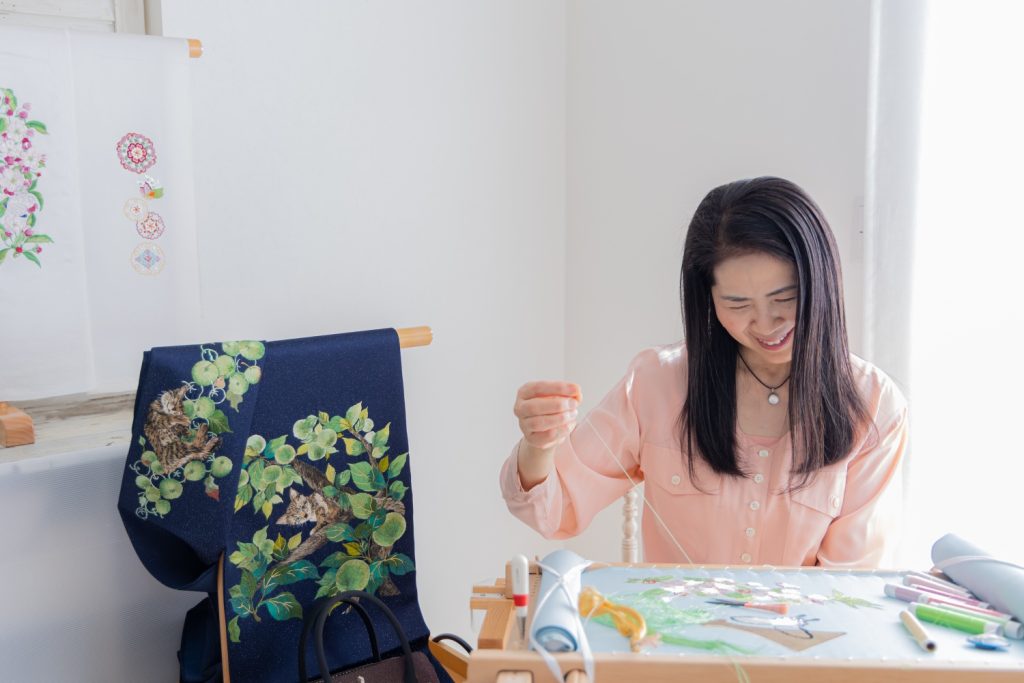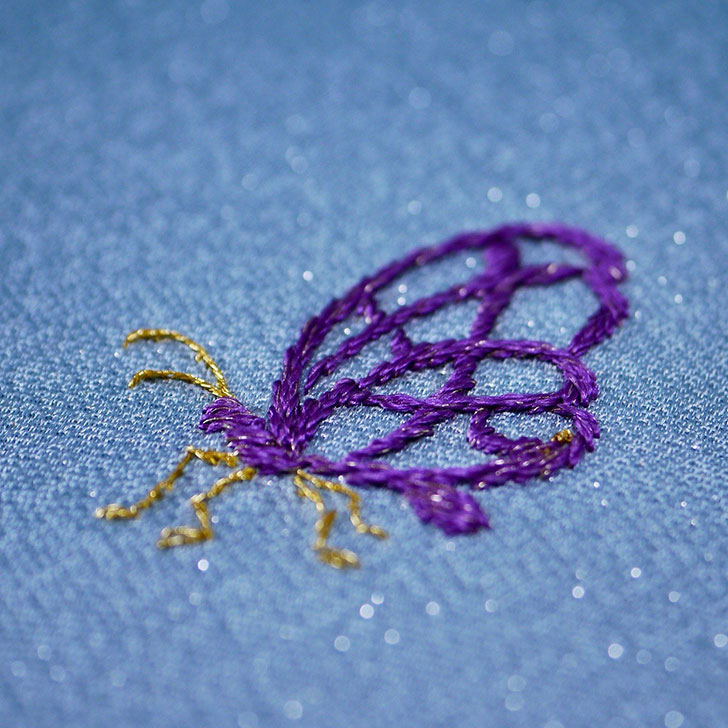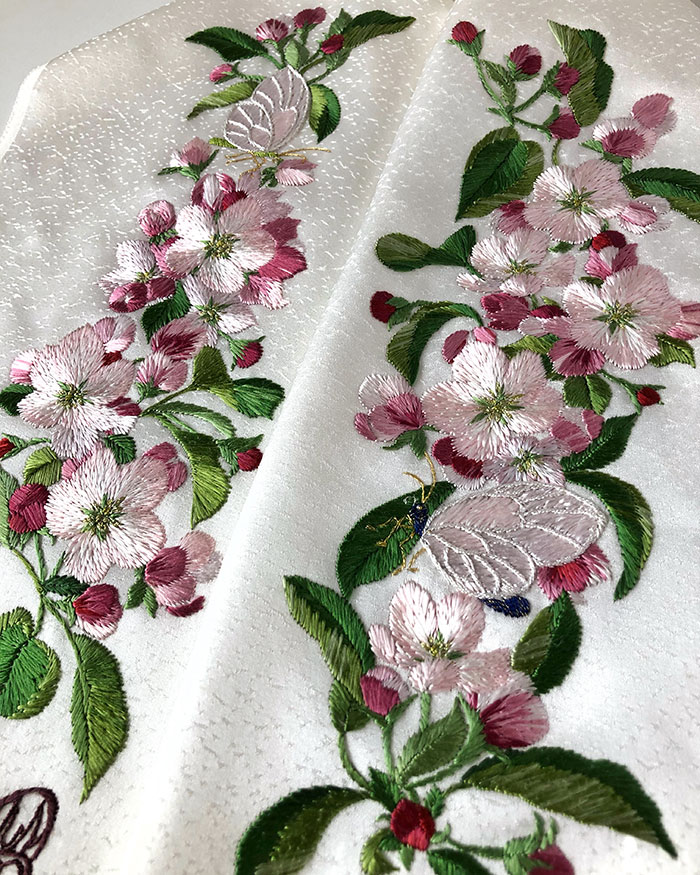Proflie
Japanese embroidery artist Hanabusa Ishihara
- Certified Embroidery Instructor, Japan Handicraft Promotion Association
- Born in Shizuoka Prefecture, currently resides in Yamato City, Kanagawa Prefecture
- First solo exhibition at Jiyugaoka STAGE Yuu in November 2017
- 2018 Costume Jewelry Award Honorable Mention
- 2019 AJC Creator’s Contest, prize winner (exhibited at Tokyo Metropolitan Art Museum)
- 2020 April lMagazine Croissant 1020 issue by Magazine House, featured in the serial “Kimono Time”.
- Featured in October 2020 web magazine Nikkei ARIA serial “ARIA’s Handiwork”

Thoughts on Japanese Embroidery

I have studied haute couture embroidery and probably all other domestic and international embroidery that Japanese people can learn for more than 20 years. I also have an instructor’s diploma.
I have visited several exhibitions of Japanese embroidery by famous instructors and groups, but for some strange reason I did not want to learn Japanese embroidery because it was just too elaborate.
Now I am thankful for that. If I had started Japanese embroidery earlier, I would have been so absorbed in it that I probably would not have paid attention to other embroideries.
This is why I think the essence of embroidery from other countries has crept into my Japanese embroidery.
Encounter with Japanese Embroidery
“Only now, only here.” These were the words of the owner of a yarn store in Kyoto, which is famous among handicraft enthusiasts and where I bought a lot of silk threads. And they were in “skeins”. Not the usual small bundles of yarn, but larger bundles shaped like churros. Not knowing what to do to make it easier to use, I pulled out just enough to use and embroidered a koala.
Then, I saw an elegant shine I had never seen before! For some reason, the smooth texture of the koala’s fur was evoked. My heart pounded with excitement.
I was instantly captivated by the deep and immeasurable brilliance of this exceptional silk thread, even though I am exposed every day to such beautiful and luminous materials as lustrous rayon thread, gold and silver thread, and crystal.
So, I immediately decided to start looking for a Japanese embroidery class to learn how to handle this wonderful silk thread.
I met Ms. Fumi Oki there and he told me, “Well, Ms. Ishihara, you started from a thread.” and laughed.

Why do I call myself Hanabusa Ishihara?

Ever since I started making original Japanese embroidery works, butterflies have somehow found their way into every piece I make. I even designed the “inscription” on my work, which is equivalent to a signature, from butterflies. Of course, butterflies are quite fascinating as a motif for embroidery. Still, I didn’t realize I liked it that much. It was strange even for me.
Recently, however, there was a strong spark in my mind, and I had a moment of clarity.
It was last year when I heard the news of the passing of designer Hanae Mori.
It was more than a decade(?) ago.
I cannot recall exactly when it was, but I had met, or rather encountered, Ms. Hanae Mori herself.
One day, I was walking along Omotesando Avenue very early in the morning. I can’t remember what it was about, but it was necessary. Naturally, there was no one on the street. There was only a security guard in the distance and a woman standing in front of the “Hanae Mori Building”, looking up at the building.
I walked along the sidewalk and pretended not to see her, but was surprised when I passed her. I shouted in my heart, “It’s Hanae Mori!”
She was wearing sunglasses, but there was no way I could have mistaken the woman with the distinctive hair style, straight back, and gracefully dressed in a suit. There was no doubt in my mind that it was her.
As a housewife, I didn’t have the courage to talk to the world-renowned celebrity, so I simply walked past her in amazement.
Looking back, I wish I had said, “I have your clothes.” (because it was true).
At the time I wondered why she was looking at the building with such deep emotion, but recently I found an old article that said, “Ms. Mori was notified in 2007, but her store moved to Roppongi in 2009 due to the reconstruction of the building.” I understood that it must have happened around that time.
It is just my imagination, but I felt that she had worked hard in this building and had many fond memories of it. I imagine that she was deeply moved by the experience and did not want to be disturbed by anyone else.
It was such a strange coincidental experience, but I had completely forgotten about it. I suddenly remembered it when I heard of her passing, and I thought, “I will inherit the butterfly!”
So I decided to take the liberty of taking the name “Hanabusa” from her name. (The character for “Hana” in Japanese Kanji is read as “Hanabusa”.)
Best memory about embroidery
In 2005, at the “EXPO 2005 AICHI JAPAN,” I saw a video of the Sema ceremony of the Merevi Order, a festival symbolizing the ancient city of Konya in Turkey, and was very impressed by its beauty.
I made a three-dimensional embroidery artwork based on the images from the video.
Soon after that, I read in a newspaper that the ceremony had been registered as an intangible cultural heritage by UNESCO, and I offered to donate it to the Turkish Embassy. The work was exhibited in Konya, Turkey.
The photos here show the newspaper article, the letter of invitation from the embassy to me, and the donated artwork.

Important words I have encountered

From a teacher I had at Vogue:
You have beautiful hands. Be sure to enter them in the competition.
Words from Mr. Toshiaki Nagakusa, one of the leading embroiderers in Japan:
In Japan, embroidery is just a pattern, but in the West, embroidery itself is the main character.
Before I started embroidery, my husband told me:
If you are going to learn something, do what you want to do and what interests you the most.
These words are the precious treasures of my embroidery life.
I have learned how to design, pattern, and make leather handbags to give shape to my embroidery works, how to use a camera, and actively tried anything that would be beneficial to embroidery.
I am grateful to the many teachers who have taught me and to my family for allowing me to continue.
I don’t know how long I will be able to continue making embroideries, but I intend to keep on making them until the end of my life.

